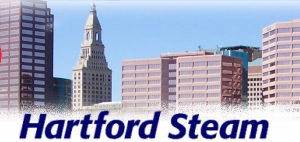The
Intelligent Use of Energy: Going Green by Going Lean
Richard R. Vaillencourt, PE,
Canterbury Engineering Associates LLC
Editor’s Note: This is the third in a series of articles on
intelligent energy use in buildings by consulting engineer Richard
Vaillencourt. We hope you’ll find them helpful as you work to optimize
your building’s energy use.
GREEN is not a primary color. It is a mixture of other colors.
Similarly, I believe, green energy can only come from a ‘mixture’ of
actions. The current definition of a green energy source includes being
renewable and nonpolluting and having minimal carbon dioxide impact and
minimal environmental impact. I suggest that these impacts must be
considered all the way back to the manufacturing stage of these
resources. For instance, how much impact does the factory making the
photovoltaic cells have in all these categories?
No matter how good your energy source is, it will always be better and
cheaper to use less of it; it therefore becomes even more important that
energy conservation be a key ingredient in going green. In fact, the
best way to start is to use less energy, then go to the most green
source available. Face it: ‘Green’ energy often is more expensive than
conventional sources. So if you want to go green in a big way, it is
very smart to go lean first.
Here are three ways to go lean:
(1) Maintain control valves. Most air-handling units have a
heating coil upstream from a cooling coil. Unfortunately, quite often
the control valves do not close all the way. Either dirt gets under the
seat or system pressures are higher than expected; or for many other
reasons, hot or chilled water is allowed to leak past the valve into the
coil. When this happens, you waste energy twice.
If the leaking heating coil is preheating the air before it gets to the
cooling coil, then you have wasted heating energy. Exactly the same
amount of energy must be removed by the cooling coil to get back to
square one. Then the cooling coil can go about its work to bring the air
temperature down to the design setpoint. The same logic applies to a
leaking cooling coil, even though it is downstream from the heating
coil. It will cause the heating valve to open wider to overheat the air
to make up for the unwanted downstream cooling until the discharge air
temperature is at its setpoint.
This is usually easy to catch with an energy management system screen.
It is just as easy, however, to find by periodically going to the
air-handling units and checking the coil temperatures. If the heating
coil is hot during the summer, or the cooling coil is cold during the
winter, it is safe to assume there is an expensive problem going on.
The important thing to remember is that it is very unlikely that you
will discover this problem any other way! Since your equipment is
compensating for the unnecessary heating or cooling right there in the
air-handling unit, there is no adverse effect outside of the unit. You
must go to the unit – either by remote control with an EMS or
physically, or both – to identify this waste of energy.
(2) Use Free Cooling. One great way to be green is to stop using
energy to control your building’s interior environment. How can you do
that? By using free outside air when it is the correct temperature to do
the job. This will only happen when you need cooling during cool or cold
months. This is actually quite often the case, since most office
buildings have a considerable internal heat gain from lights, office
equipment and people. If you have a data center, you need cooling all
year.
Most air-handling units operate with a discharge air temperature
setpoint of 55 degrees F when in cooling mode. The return temperature to
the unit is usually in the 75-80 F range. It makes no sense to use
chilled water to force the 80 F return air back down to 55 F when the
outside air is already at or below 55 F. Simply dump all the return air
and bring in all the outside air that is needed to deliver 55 F air to
the supply ductwork. This should be done with a mixed air temperature
setpoint controller. That way the amount of outside air can be adjusted
when it is very cold to be just enough to mix with the warm return air
to produce the 55 F discharge air temperature.
(3) Install variable frequency drives. If you have a variable air
volume (VAV) system that uses variable inlet vanes to control the air
volume delivered by the fan to match the varying volume required by the
VAV boxes, you already have an efficient system. It can still be
improved, however. The installation of a variable frequency drive (VFD)
will improve the efficiency of the fan operation to the highest possible
level.
If you have a balancing valve on the output of your pumps that is
partially closed to throttle the flow, that throttled valve is creating
an artificial pressure drop. Any pressure drop causes the horsepower to
increase. If the pressure drop is artificially applied to control the
pump flow rate, the installation of a VFD will control the flow rate and
allow the throttled valve to be opened. The pump horsepower will be
reduced to only what is actually needed.
Being green involves more than passively selecting the ’right’ energy
source. Plus green energy sources can cost you more money. If you mix in
as much energy conservation as possible, you can select the more
expensive green energy source and still be cost-effective.
More Articles/Resources
|




